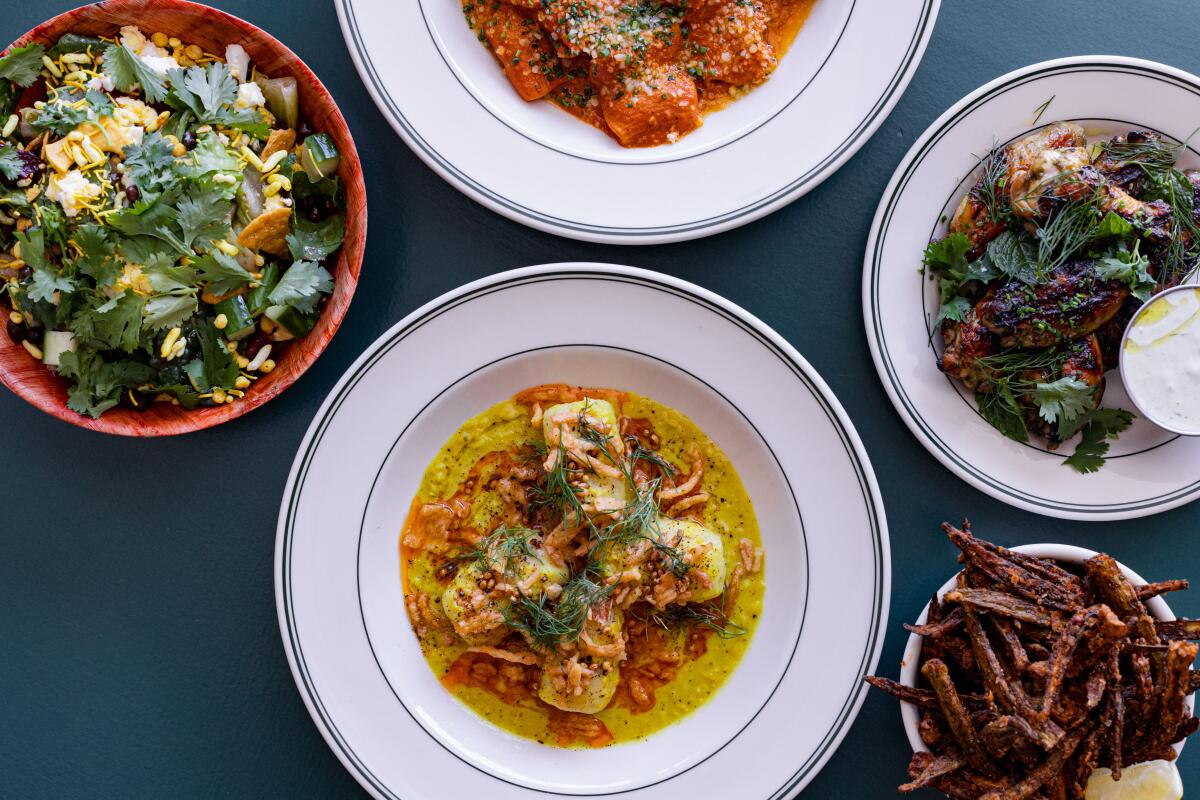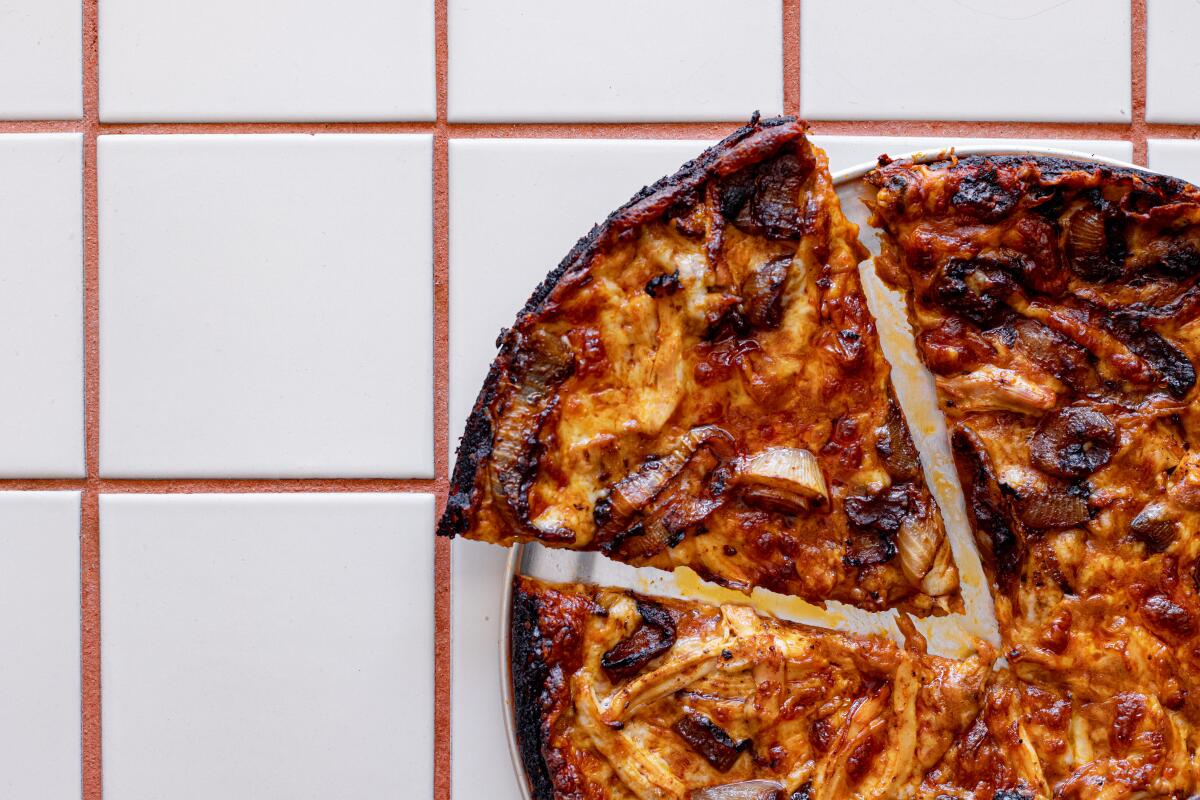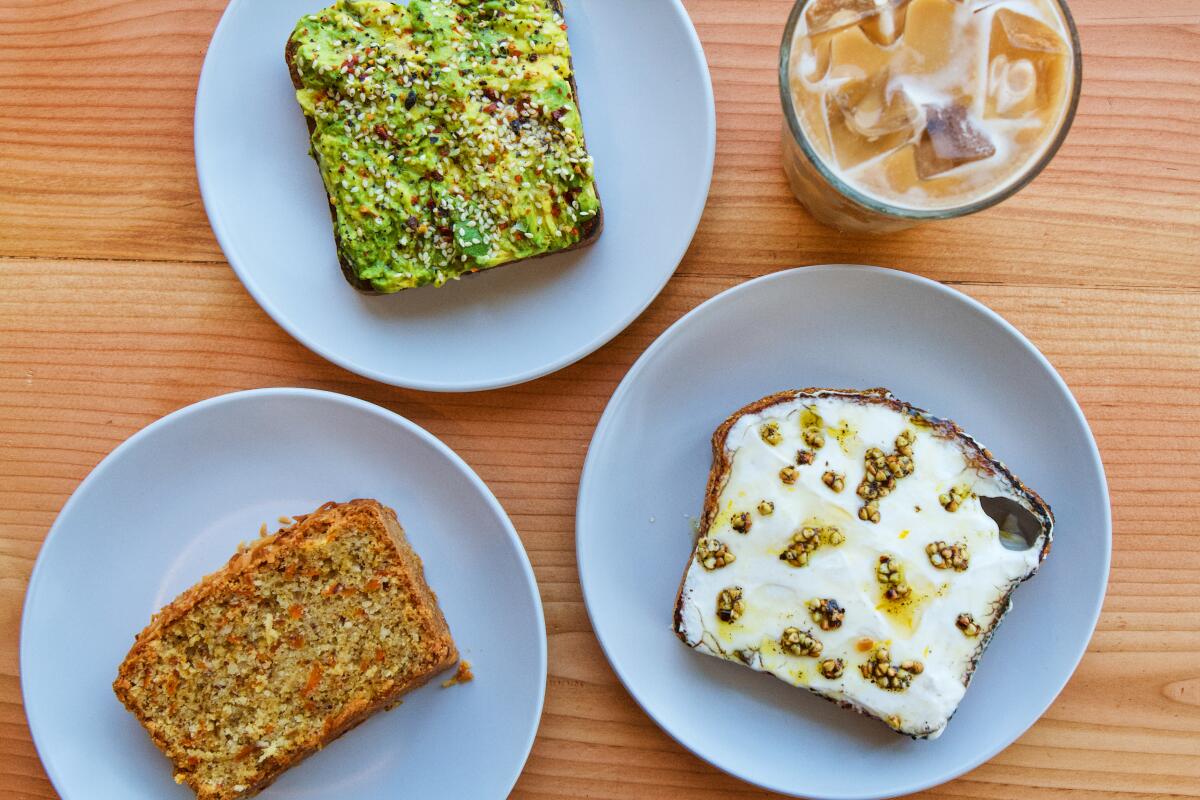Can we let go of the term ‘fusion cooking’ once and for all?

Before settling at a table for my first dinner at Pijja Palace, the new sports bar in Silver Lake and the subject of this week’s review, I had already studied the menu online and pinpointed what my friend and I would be ordering.
We’d start with wings marinated in what is essentially cilantro-mint chutney and served with a side of ranch dressing spiked with curry leaves. Then we’d dive into lamb kebab sliders; a pizza with a gentle hot sauce spiced in the garlicky, vinegar-tinged manner of Goan vindaloo (one of three options) and crowned with cubes of chicken tikka and rings of tandoori onions; and the restaurant’s instant hit, malai rigatoni.
It was while peering down at the plate of pasta — about to taste its velvety tomato-cream sauce with a backbeat of sweet spices and a dusting of Parmesan — that a thought leapt involuntarily from my brain: “This is fusion cooking.”
I kicked the sentence right back where it came from, imagining it spelled out on an otherwise blank sheet of paper in the IBM electronic typewriter I remember in my parents’ circa-1980s office. I saw myself yanking out the page, crumpling it with satisfaction and tossing it over my shoulder for dramatic effect.
Enjoying this newsletter? Consider subscribing to the Los Angeles Times
Your support helps us deliver the news that matters most. Become a subscriber.
The term “fusion” as a signifier of an inventive variation on “East meets West cooking” — itself a ridiculous, outmoded generalization — continues to lurk in the margins of American dining culture and food writing. It lives in my head against my will. I came of age as a curious eater and a restaurant cook during its most flagrant use throughout the 1990s. I haven’t used the word in any writing in years.
To rewind: The modern notion of “fusion cuisine” arrived in the early 1980s, most frequently attributed to Wolfgang Puck and Chinois on Main, the Santa Monica restaurant he opened with Barbara Lazaroff. “Since opening in 1983,” reads the self-description on its website, “Chinois on Main has boldly combined Chinese tradition and fresh California ingredients with contemporary French techniques, and introduced the world to Asian fusion cuisine.”
The restaurant popularized “Chinese chicken salad,” a mix of shredded cabbage, wisps of chicken and crushed deep-fried wonton skins tossed in rice wine vinegar, soy sauce and pickled ginger. I’ve seen customers still clamoring for it at Puck restaurants.
Roy Yamaguchi — who was raised in Japan on a U.S. military base outside of Tokyo and graduated from the Culinary Institute in 1976 — cooked in bygone Beverly Hills restaurants as L’Escoffier and L’Ermitage before relocating to Honolulu and opening his first Roy’s in 1988. He melded styles on the restaurant’s menu that drew on his connection to Hawaii via his grandfather, who had run a tavern and general store on Maui during Yamaguchi’s childhood.
As his brand expanded, and eventually franchised, across the mainland, his name became synonymous with fusion — for dishes like misoyaki butterfish and his heavily glazed “wood-smoked, Szechuan-style ribs,” and also for out-there creations like buttered crab pizza adorned with asparagus, onion and melted brie.
Eat your way across L.A.
Get our weekly Tasting Notes newsletter for reviews, news and more.
You may occasionally receive promotional content from the Los Angeles Times.
These chefs, among many others, were markers of an era. By the time I began reviewing restaurants in the early 2000s, fusion cuisine came in several other names: Pacific Rim, Pan-Pacific, Pan-Asian and Cal-Asian. I remember condensing the movement to three words in my head: wasabi mashed potatoes.
That contempt, I see now, disregards some positives in the trend. Young immigrant and second-generation chefs could look beneath the mix-and-match formlessness to see how they might innately combine the foods of their backgrounds with the culture around them. Also, to state the obvious: Through trade routes, war, colonialization, imperialism, immigration and globalization, the mingling of cuisines has been a part of human history forever.
But “fusion cuisine” remains a hydra of a slur. The term is usually assumed to be shorthand for “Asian fusion,” which is insultingly reductive; Asian, Asian American and Pacific Island cultures are not monoliths. It also carries a bad taste that suggests one is doing something silly or slapdash or nonsensical. No wonder chefs who are cooking to their personal narrative say in interviews, “Don’t call what I’m doing ‘fusion.’”
If Los Angeles was an early adaptor of fusion, factions of its culinary circles also knew when enough was enough. When Kogi appeared in 2008, drawing hourlong waits for its Korean tacos and forever changing American food truck and street food cultures, a lot of us were starting to understand that by pronouncing a few more consonants we could absorb a far greater understanding of what we were eating and whose hands were preparing the food.
The advent of Kogi helped engender an across-the-board understanding that the pluralism of Los Angeles — expressed through the combining of food cultures in thoughtful, appealing ways — didn’t need a label. It just was. I can’t imagine anyone describing Roy Choi’s cooking as “fusion.”

So it didn’t much surprise when I noticed a quote from Pijja Palace owner Avish Naran, a native of Echo Park who graduated from Edward R. Roybal Learning Center , in a Robb Report article by Andy Wang. “Growing up in L.A.,” Naran told Wang, “you notice there’s a lot of similarities between a lot of different cuisines. Everything we’re seeing today is completely organic. Like, nothing’s a fusion, everybody’s just doing what they grew up with. I think L.A. is such a huge cultural hub, with a history of great casual restaurants.”
Interestingly, I noticed a new restaurant called April 90s Something just opened next to Pijja Palace. The tag on its sign: “Thai Fusion.”
Among chicken larb, papaya salad and drunken noodles, the most radical departure to my mind is a dish of spaghetti tangled with chile, basil and bacon. If owner Hattaikarn Tongtanom feels a sense of agency with “fusion,” I’m here for it. But if I write any more about the restaurant, I’ll likely gently sidestep the word and do my best to write about the cooking in its own context and on its own merit.
Have a question?
The 2022 L.A. Times Food Bowl launches next week
The L.A. Times Food Bowl returns in September with a month of events, beginning with a launch party on Sept. 1 at Grandmaster Recorders in Hollywood. Tickets remain for events including dinner at Meals by Genet, the 2022 Gold Award winner; a collaborative dinner with Koreatown’s Kinn and chef Kevin Lee; and the Food Bowl’s three-evening Night Market event.
Other stories
— Speaking of Food Bowl: Stephanie Breijo and Jenn Harris talk with six chefs cooking as part of the month-long event — including Jon Yao from Kato, Nicole Rucker from Fat + Flour and Justin Pichetrungsi from L.A. Times Restaurant of the Year Anajak Thai Cuisine — and asked them to name their favorite places to eat in L.A.
— The long-awaited coffee shop from local roastery Canyon Coffee finally open in Echo Park; star baker Sasha Piligian is making tea cakes, cookies and other pastries. Stephanie has the details with other news of the week.
— For the L.A. Times Book Club, Food editor Daniel Hernandez sat down with chef Keith Corbin to discuss Corbin’s powerful memoir, “California Soul: An American Epic of Cooking and Survival.” Watch their conversation.

Eat your way across L.A.
Get our weekly Tasting Notes newsletter for reviews, news and more.
You may occasionally receive promotional content from the Los Angeles Times.



